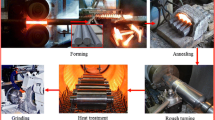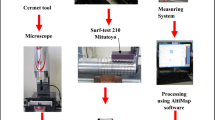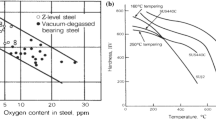Abstract
One of the major challenges faced by industries nowadays is to achieve the most suitable response values while fulfilling the requirements of both the manufacturers and end users. In order to achieve this goal and meet these requirements, optimization techniques have to be introduced and applied. The present study investigates the application of three multi-objective optimization techniques (TOPSIS- Technique for Order Performance by Similarity to Ideal Solution, DEAR- Data Envelopment Analysis Ranking and GRA- Grey Relational Analysis) that are based on the signal to noise (S/N) ratio in order to achieve the best technological parameters represented by the arithmetic mean roughness (Ra), the wear of the inserts (Vb) and the chip removal rate (MRR) during the turning of a refractory alloy (Inconel 718) with a composite ceramic cutting tool (CC670) following a Taguchi plan (L18-21 × 33). The objective is to find out the best combination of the cutting parameters represented by the cutting speed (Vc), the feed rate (f), the depth of cut (ap) and the nose radius (r) that leads to the minimization of (Ra) and (Vb) along with the maximization of (MRR). The results achieved to demonstrate the effectiveness of the three methods that have led to similar results represented by the optimal parameters represented by Vc = 200 m/min, f = 0.16 mm/rev and ap = 0.25 mm. However, in terms of the tool nose radius, the DEAR approach gave a nose radius of r = 1.2 mm while both the TOPSIS and GRA methods led to r = 1.6 mm.




Similar content being viewed by others
References
Rahman M, Seah W K H and Teo T T 1997 The machinability of Inconel 718. J. Mater. Process. Technol. 63: 199–204
Mahesh K, Philip J T, Joshi S N and Kuriachen B 2021 Machinability of Inconel 718: a critical review on the impact of cutting temperatures. Mater. Manuf. Process. 36: 753–791
Roy S, Kumar, Panda R and Das R K 2018 A brief review on machining of Inconel 718. Mater. Today Proc. 5: 18664–18673
Kitagawa T, Kubo A and Maekawa K 1997 Temperature and wear of cutting tools in high-speed machining of Inconel 718 and Ti 6AI 6V 2Sn. Wear 202: 142–148
Devillez A, Le Coz G, Dominiak S and Dudzinski D 2011 Dry machining of Inconel 718 workpiece surface integrity. J. Mater. Process. Technol. 211: 1590–1598
D’addona D M, Raykar S J and Narke M M 2017 High speed machining of Inconel 718: tool wear and surface roughness analysis. Procedia CIRP 62: 269–274
Thirumalai R, Senthilkumaar J S, Selvarani P, Arunachalam R M and Senthilkumaar K M 2012 Investigations of surface roughness and flank wear behavior in machining of Inconel 718. Aust. J. Mech. Eng. 10: 157–168
Zeilmann R P, Fontanive F and Soares R M 2017 Wear mechanisms during dry and wet turning of Inconel 718 with ceramic tools. Int. J. Adv. Manuf. Technol. 92: 2705–2714
Tebassi H, Yallese M Y, Meddour I, Girardin F and Mabrouki T 2017 On the modeling of surface roughness and cutting force when turning of Inconel 718 using artificial neural network and response surface methodology: accuracy and benefit. Period. Polytech. Mech. Eng. 61: 1–11
Cantero J L, Álvarez J, Miguélez M H and Marín N C 2013 Analysis of tool wear patterns in finishing turning of Inconel 718. Wear 297: 885–894
Behera G C, Thrinadh J and Datta S 2021 Influence of cutting insert (uncoated and coated carbide) on cutting force, tool-tip temperature, and chip morphology during dry machining of Inconel 825. Mater. Today Proc. 38: 2664–2670
Padhan S, Das S R, Das A, Alsoufi M S, Ibrahim A M M and Elsheikh A 2022 Machinability investigation of Nitronic 60 steel turning using SiAlON ceramic tools under different cooling/lubrication conditions. Materials 15: 2368
Tan L, Yao C, Li X, Fan Y and Cui M 2022 Effects of machining parameters on surface integrity when turning Inconel 718. J. Mater. Eng. Perform. 1–11(10): 157–168
Rajeswari B and Amirthagadeswaran K S 2017 Experimental investigation of machinability characteristics and multi-response optimization of end milling in aluminum composites using RSM based grey relational analysis. Measurement 105: 78–86
Kant G and Sangwan K S 2014 Prediction and optimization of machining parameters for minimizing power consumption and surface roughness in machining. J. Clean. Prod. 83: 151–164
Lin H L 2013 Optimization of Inconel 718 alloy welds in an activated GTA welding via Taguchi method, gray relational analysis, and a neural network. Int. J. Adv. Manuf. Technol. 67: 939–950
Sanghvi N, Vora D, Patel J and Malik A 2021 Optimization of end milling of Inconel 825 with coated tool: a mathematical comparison between GRA, TOPSIS and Fuzzy Logic methods. Mater. Today Proc. 38: 2301–2309
Ramanujam R, Muthukrishnan N and Raju R 2011 Optimization of cutting parameters for turning Al-SiC (10p) MMC using ANOVA and grey relational analysis. Int. J. Precis. Eng. Manuf. 12: 651–656
Touggui Y, Belhadi S, Mabrouki T, Temmar M and Yallese M A 2020 Dry turning optimization of austenitic stainless steel 316L based on Taguchi and TOPSIS approaches. Matériaux Tech. 108: 401–410
Singaravel B and Selvaraj T 2015 Optimization of machining parameters in turning operation using combined TOPSIS and AHP method. TehnickiVjesnik 22: 1475–1480
Singh A, Datta S and Mahapatra S S 2011 Application of TOPSIS in the Taguchi method for optimal machining parameter selection. J. Manuf. Sci. Prod. 11: 49–60
Gopal P M and Prakash K S 2018 Minimization of cutting force, temperature and surface roughness through GRA, TOPSIS and Taguchi techniques in end milling of Mg hybrid MM. Measurement 116: 178–192
Vaddi V, Ch S R, Pogaku V and Bushaboina S 2018 Optimization of electrical discharge machining of titanium alloy (Ti-6Al-4 V) using Taguchi-DEAR method. SAE Technical Paper. 2018-28-0032
Muthuramalingam T, Vasanth S, Vinothkumar P, Geethapriyan T and Rabik M M 2018 Multi criteria decision making of abrasive flow oriented process parameters in abrasive water jet machining using Taguchi–DEAR methodology. Silicon 10: 2015–2021
Phan N H and Muthuramalingam T 2021 Multi criteria decision making of vibration assisted EDM process parameters on machining silicon steel using Taguchi-DEAR methodology. Silicon 13: 1879–1885
Moganapriya C, Rajasekar R, Mohanraj T, Gobinath V K, Kumar P S and Poongodi C 2021 Dry machining performance studies on TiAlSiN coated inserts in turning of AISI 420 martensitic stainless steel and multi-criteria decision making using Taguchi-DEAR approach. Silicon 14: 4183–4196
Hong S N and Vo ThiNhu U 2021 Multi-objective optimization in turning operation of AISI 1055 steel using DEAR method. Tribol. Ind. 43: 57–65
Pathapalli V R, Reddigari M R, Anna E K, Rao P S and Reddy D V R 2021 Modeling of the machining parameters in turning of Al-5052/TiC/SiC composites: a statistical modeling approach using grey relational analysis (GRA) and response surface methodology (RSM). Multidiscip. Model. Mater. Struct. 17: 990–1006
Kant R and Dhami S S 2021 Multi-response optimization of parameters using GRA for abrasive water jet machining of EN31 steel. Mater. Today Proc. 47: 6141–6146
Shanmugam A, Mohanraj T, Krishnamurthy K and Gur A K 2021 Multi-response optimization on abrasive waterjet machining of glass fiber reinforced plastics using taguchi method coupled with topsis. Surf. Rev. Lett. 28(12): 2150120
Rammohan S, Kumaran S T, Uthayakumar M and Velayudham A 2021 Application of TOPSIS optimization in abrasive water jet machining of military grade armor steel. Hum. Factors Mech. Eng. Defense Saf. 5: 1–8
Kouahla I, Yallese M A, Belhadi S, Safi K and Nouioua M 2022 Tool vibration, surface roughness, cutting power, and productivity assessment using RSM and GRA approach during machining of Inconel 718 with PVD-coated carbide tool. Int. J. Adv. Manuf. Technol. 122: 1835–1856
Kumar P M, Sivakuma K and Kumar S V 2022 Experimental investigation of electrical discharge machining of Inconel 718 using a tib2-cu sintered composite electrode. Mater. Technol. 56: 131–138
Raj A, Misra J P, Khanduja D, Saxena K K and Malik V 2022 Design, modeling and parametric optimization of WEDM of Inconel 690 using RSM-GRA approach. Int. J. Interact. Des. Manuf. (IJIDeM). https://doi.org/10.1007/s12008-022-00947-5
Abhilash P M and Chakradhar D 2022 Multi-response optimization of wire EDM of Inconel 718 using a hybrid entropy weighted GRA-TOPSIS method. Process Integr. Optim. Sustain. 6: 61–72
Alsoruji G, Muthuramalingam T, Moustafa E B and Elsheikh A 2022 Investigation and TGRA based optimization of laser beam drilling process during machining of Nickel Inconel 718 alloy. J. Mater. Res. Technol. 18: 720–730
Eskandari B, Bhowmick S and Alpas A T 2022 Turning of Inconel 718 using liquid nitrogen: multi-objective optimization of cutting parameters using RSM. Int. J. Adv. Manuf. Technol. 120: 3077–3101
Sivalingam V, Poogavanam G, Natarajan Y and Sun J 2021 Optimization of atomized spray cutting fluid eco-friendly turning of Inconel 718 alloy using ARAS and CODAS methods. Int. J. Adv. Manuf. Technol. 120: 4551–4564
Ren X, Liu Z, Liang X and Cui P 2021 Effects of machined surface integrity on high-temperature low-cycle fatigue life and process parameters optimization of turning super alloy Inconel 718. Materials 14(2428): 1–16
Divya Ch, Raju L S and Singaravel B 2021 Experimental investigation of different cutting conditions in turning of Inconel 718. IOP Conf. Ser. Mater. Sci. Eng. 1057–012070: 1–8
Senthilkumar K M, Thirumalai R, Selvam T A, Natarajan A and Ganesan T 2021 Multi objective optimization in machining of Inconel 718 using Taguchi method. Mater. Today Proc. 37: 3466–3470
Pinheiro C, Kondo M Y, Amaral S S, Callisaya E S, De Souza J V C, De Sampaio Alves M C and Ribeiro M V 2021 Effect of machining parameters on turning process of Inconel 718. Mater. Manuf. Process. 36: 1421–1437
Thirumalai R, Seenivasan M and Panneerselvam K 2021 Experimental investigation and multi response optimization of turning process parameters for Inconel 718 using TOPSIS approach. Mater. Today Proc. 45: 467–472
Jafarian F 2020 Electro discharge machining of Inconel 718 alloy and process optimization. Mater. Manuf. Process. 35: 95–103
Frifita W, Salem S B, Haddad A and Yallese M A 2020 Optimization of machining parameters in turning of Inconel 718 Nickel-base super alloy. Mech. Ind. 21(2): 203
Khanna N, Shah P, Agrawal C, Pusavec F and Hegab H 2020 Inconel 718 machining performance evaluation using indigenously developed hybrid machining facilities: experimental investigation and sustainability assessment. Int. J. Adv. Manuf. Technol. 106: 4987–4999
Kar T, Mandal N K and Singh N K 2020 Multi-response optimization and surface texture characterization for CNC milling of Inconel 718 alloy. Arab. J. Sci. Eng. 45: 1265–1277
Raju B S, Chandrasekhar U and Manjunath L H 2020 Studies on process parameter optimization of Inconel 718 turning operation using Taguchi based grey relational analysis. Int. J. Veh. Struct. Syst. 12: 465–469
Pervaiz S, Kannan S and Subramaniam A 2020 Optimization of cutting process parameters in inclined drilling of Inconel 718 using finite element method and Taguchi analysis. Materials 13(18): 3995
Karna S K and Sahai R 2012 An overview on Taguchi method. Int. J. Eng. Math. Sci. 1: 1–7.
Zerti O, Yallese M A, Belhadi S, Bouzid L 2017 Taguchi design of experiments for optimization and modeling of surface roughness when dry turning X210Cr12 steel. In Applied Mechanics. Behavior of Materials and Engineering Systems, pp. 275–288
Chakraborty S and Chakraborty S A 2022 Scoping Review on the Applications of MCDM Techniques for Parametric Optimization of Machining Processes. Archives of Computational Methods in Engineering. 1-22
Zolpakar N A, Yasak M F and Pathak S 2021 A review: use of evolutionary algorithm for optimization of machining parameters. Int. J. Adv. Manuf. Technol. 115: 31–47
Moganapriya C, Rajasekar R, Mohanraj T, Gobinath V K, Kumar P S and Poongodi C 2022 Dry machining performance studies on TiAlSiN coated inserts in turning of AISI 420 martensitic stainless steel and multi-criteria decision making using Taguchi-DEAR approach. Silicon 14: 4183–4196
Nguyen H P, Pham V D and Ngo N V 2018 Application of TOPSIS to Taguchi method for multi-characteristic optimization of electrical discharge machining with titanium powder mixed into dielectric fluid. Int. J. Adv. Manuf. Technol. 98: 1179–1198
Belhadi S, Kaddeche M, Chaoui K and Yallese M A 2016 Machining optimization of HDPE pipe using the Taguchi method and Grey relational analysis. Int. Polym. Process. 31: 491–502
Zerti O, Yallese M A, Khettabi R, Chaoui K and Mabrouki T 2017 Design optimization for minimum technological parameters when dry turning of AISI D3 steel using Taguchi method. Int. J. Adv. Manuf. Technol. 89: 1915–1934
Acknowledgements
The present research was undertaken by the “Metal Cutting Research Group” of the Structures and Mechanics Laboratory (LMS) of Université 8 Mai 1945, Guelma, Algeria, and received funding from the General Directorate of Scientific Research and Technological Development (DGRSDT) under the PRFU research project A11N01UN240120190001.
Author information
Authors and Affiliations
Corresponding author
Nomenclature
Nomenclature
Acronyms
- AHP:
-
Analytic Hierarchy Process
- ANN:
-
Artificial Neural Network
- ARAS:
-
Additive Ratio Assessment
- ASCF:
-
Atomized Spray Cutting Fluid
- CODAS:
-
COmbinative Distance-based ASsessment
- DEAR:
-
Data Envelopment Analysis based Ranking methodology
- DFA:
-
Desirability Function Approach
- EDM:
-
Electrical Discharge Machining
- FEM:
-
Finite Element Method
- FFD:
-
Full Factorial Design
- FIS:
-
Fuzzy Inference System
- GRA:
-
Grey Relational Analysis
- NSGA-II:
-
Non dominated Sorting Genetic Algorithm II
- MRR:
-
Material Removal Rate
- PSO:
-
Particle Swarm Optimization
- S/N:
-
Signal to Noise ratio
- TGRA:
-
Taguchi Grey Relational Analysis
- TOPSIS:
-
Technique for Order Preference by Similarity to Ideal Solution
Roman letters
- ap:
-
Depth of cut
- f:
-
Feed rate
- I:
-
Peak current
- r:
-
Nose radius
- Ra:
-
Arithmetic mean roughness
- Toff:
-
Pulse-off time
- Ton:
-
Pulse-on time
- V:
-
Gap voltage
- Vb:
-
Insert wear
- Vc:
-
Cutting speed
Rights and permissions
About this article
Cite this article
Boumaza, H., Belhadi, S., Yallese, M.A. et al. Optimization of surface roughness, tool wear and material removal rate in turning of Inconel 718 with ceramic composite tools using MCDM methods based on Taguchi methodology. Sādhanā 48, 1 (2023). https://doi.org/10.1007/s12046-022-02060-5
Received:
Revised:
Accepted:
Published:
DOI: https://doi.org/10.1007/s12046-022-02060-5




